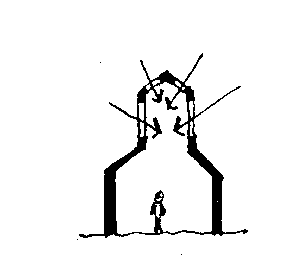| Roofing
Design Considerations:
Materials- Use dark, heat absorbing materials in colder
climates. Use light, reflective materials in warm climates. Consider recycled
and local materials.
Storm Water Drainage- Consider directing storm water into underground
cisterns or storage tanks. Do not direct the storm water into one place, because
this will cause erosion. Allow the water to flow off of the roof in many places, and
control where the water will flow, once it hits the ground. Gutters can be used, but
must be maintained to avoid any possible blocking. This can cause water damage to
the roof.
Roof top units- The air intake units should be located away from
loading docks and streets, or factory smoke stacks.
Solar Units- Photovoltaic power and fuel cells generate enough
electricity to cover the building’s base load during nighttime hours. These are
non-polluting, producing only hot water and CO2 as by-products.
Tools:
Consult with mechanical engineers
Case Studies to research:
Materials-
Picard Residence, CA.
John Picard (use of recycled rubber for roofing insulates the home)
Storm Water Drainage-
The Gap Inc. in San Bruno, CA
William McDonough + Partners
(uses a grass roof to attract rain water and decrease run-off. The grass roof
also acts as insulation from heat from the sun).
Roof top units-
The National Audubon Society Headquarters, New York, NY
Croxton Collaborative Associates
Further Information:
EPA / DOE Energy Star Program
Moore, F. Environmental Control Systems: Heating, Lighting, Cooling. New
York: McGraw-Hill, Inc, 1993.
The Ecology of Architecture: A Complete Guide to Creating the Environmentally
Conscious Building by Laura Zeiher.
Roy, Rob. Super Insulated Houses and Underground Houses. New York:
Sterling Publishing, 1994.
National Audubon Society Audubon House: Building the Environmentally Responsible,
Energy-Efficient Office. New York, NY: John Wiley and Sons, Inc. 1994. |
